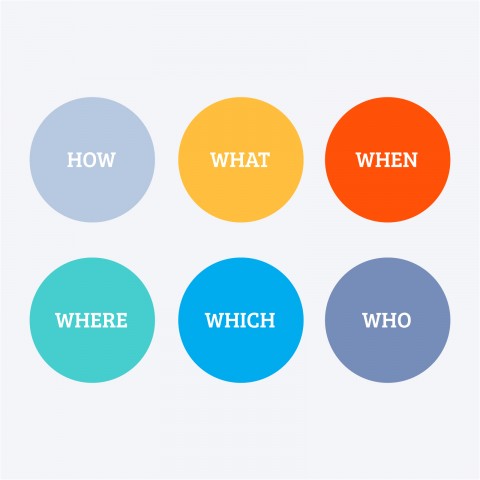

Do you ever struggle with the formulation of Dutch sentences? You have all the tools you need to form a sentence: You know what you want to say, and you know the words to use. However, at the moment of truth, you just can’t find a way to fit them all together.
This can be very frustrating. You’ve made some great progress learning Dutch vocabulary. You’re also starting to understand Dutch verbs and tenses more and more. But in Dutch grammar, word order is essential in putting this knowledge into practice. So, how do you form a Dutch sentence?
Help is near. Master this skill with this Dutch word order guide from DutchPod101.

Table of Contents

In this guide, we’ll mostly talk about the most common type of sentence: declaratives. You make a declarative sentence when you make a statement. It’s not used to give orders or to ask questions (however, we will discuss interrogative sentences later on in this guide).
Let’s start with the most basic sentence in Dutch, consisting of only a subject and a verb:
Subject + Verb
Contrary to languages like Spanish or Italian, the subject is almost never dropped in Dutch. A Dutch sentence structure is not complete without the subject.

The (direct) object in Dutch is called lijdend voorwerp, which translates to “leading entity/object.” In Dutch language word order, it normally comes right after the verb.
Subject + Verb + (Direct) Object
The object can be direct or indirect. In the above examples, the object is direct. However, you can also add an indirect object after the direct object.
Subject + Verb + Direct object + Indirect object
A direct object is a noun or pronoun that’s directly affected by the actions of the subject. An indirect object is a person or thing that’s involved in the actions in some way.
Okay, let’s make it a bit more complicated. Let’s advance and add a complement to the sentence. A complement can be, for example, an adjective or an adverb.

Adjectives describe nouns, giving extra information about them. They provide details and make the noun more interesting. So where should you place them in a sentence?
Most Dutch adjectives go BEFORE the noun they describe.
So when we add the adjective to the sentence, it looks like this:
Subject + Verb + Adjective + Direct object + Adjective + Indirect object
As you can see, the adjectives are placed right before the nouns they describe.
Adverbs modify the meaning of verbs, adjectives, or other adverbs, or make their meaning more precise. Thus, they describe verbs, adjectives, or adverbs.
In Dutch word order, adverbs that modify a verb usually come AFTER that verb:
Subject + Verb + Adverb
If the adverb influences another adverb, the sentence would be:
Subject + Verb + Adverb + Adverb
And if the adverb modifies an adjective, the Dutch sentence structure would be:
Subject + Verb + Adverb + Adjective + Direct object
So, as you can see, if the adverb modifies an adverb or adjective, it usually comes AFTER the verb and BEFORE the adverb or adjective.
There are different kinds of adverbs, from adverbs describing time, frequency, place, manner, or degree, to those that help you connect your thoughts.
Do you want to use more than one adverb in a sentence? Then the following Dutch adverb placement is common:
Time-Manner-Place
Let’s have a look at these three specific types of adverbs, and place them in the sentences we’ve been using:
Let’s make it even more complicated:
Subject + Verb + Adverb of time + Adverb of manner + Adverb of place + Adjective + Direct object + Adjective + Indirect object
However, it’s also possible to place the time and place adverbs at the beginning of the sentence. This is generally done to put emphasis on these adverbs:
Did you notice that, in this case, the verb comes BEFORE the subject? Be sure to make a note of this difference for your future reference.
Okay, these sentences are getting a bit crazy with all the adverbs, adjectives, and objects. Luckily, sentences don’t have to be this complicated. You can just use a subject, verb, object, and maybe one adjective or adverb to get into more detail. It’s better to keep it simple when you start learning a language.

Regarding the conjugation of verbs, Dutch is quite a strange language. Did you know it’s possible to add a verb at the end of a sentence? You can’t do this with all Dutch conjugations, but in the present perfect, past perfect, future simple, future perfect, conditional, and conditional perfect, verbs may be added to the end of a sentence.
Let’s have a look at the eight Dutch tenses:
| The eight tenses of the regular verb praten (“to talk”) | |||
|---|---|---|---|
| 1. Onvoltooid tegenwoordige tijd (“Present Simple”) | Describes something that is happening now | Ik praat | “I talk” |
| 2. Onvoltooid verleden tijd (“Past Simple”) | Describes a situation that happened in the past | Ik praatte | “I talked” |
| 3. Voltooid tegenwoordige tijd (“Present Perfect”) | Describes something that happened in the past and has already ended | Ik heb gepraat | “I have talked” |
| 4. Voltooid verleden tijd (“Past Perfect”) | Describes an action or event that happened in the past and ended in the past | Ik had gepraat | “I had talked” |
| 5. Onvoltooid tegenwoordige toekomende tijd (“Future Simple”) | Talks about something that will happen in the future | Ik zal praten | “I will talk” |
| 6. Voltooid tegenwoordige toekomende tijd (“Future Perfect”) | Describes an action that will have been completed before another action in the future | Ik zal hebben gepraat | “I will have talked” |
| 7. Onvoltooid verleden toekomende tijd (“Conditional”) | Used in a “what if” scenario, used to speculate about something | Ik zou praten | “I would talk” |
| 8. Voltooid verleden toekomende tijd (“Conditional Perfect”) | Describes a future hypothetical situation in the past | Ik zou hebben gepraat | “I would have talked” |
So how does it work with the other components of the Dutch sentence structure?
Here’s an example for all six of the Dutch tenses that can make sentences end with a verb:
As you can see, the Dutch sentence structure for these tenses will be:
Subject + Working verb + Adverb + Adjective + Direct object + Adjective + Indirect object + Other verb
Do you think this Dutch sentence word order is very complicated? Then make sentences with less components. For example:
The imperative (in Dutch: de gebiedende wijs) is used for commands, orders, and suggestions. Similar to English, there’s no subject in this conjugation, and the sentences usually start with the verb.

Let’s have a look at the imperative word order in Dutch. These examples show two different word orders:
Verb + Direct object + Adverb
Verb + Adverb + Direct object
These different word orders are caused by the fact that the first adverb is connected to the object (de deur, meaning “the door”), while the second adverb is related to the verb (praten, meaning “to talk”).
As you can notice, these sentences are often shorter than descriptive sentences. But of course, you can also add several adverbs, adjectives, or an indirect object.
Verb + Adverb + ( Adjective ) + Direct object + ( Adverb ) + ( Indirect object )
To make a question, turn the verb and subject of a statement around.
Verb + Subject + Adverb + ( Adjective ) + Direct object + ( Adjective ) + ( Indirect object )

Another way to make questions is through question words :
As you can see, the Dutch word order with question words is:
Query word + Verb + Subject + Direct object
The wie (“who”) question word is an exception, as there’s no subject mentioned.
In this guide, you’ve learned the ins and outs of the word order in Dutch sentences. You now know all about the Dutch sentence structure.
Do you feel ready to put all of this knowledge into practice? Or would you like to do more Dutch word order exercises?
Make sure to discover everything that DutchPod101.com has to offer, such as the multiple vocabulary lists with audio recordings and other useful free resources. Learn some new words and put them into practice to form your own Dutch sentences.
Would you like a private teacher? DutchPod101 also has the MyTeacher Premium PLUS service. Here, you can get private one-on-one classes about Dutch word order and other crucial language features, with personalized feedback, interactive assignments, and professional advice.
Let’s master the Dutch language!